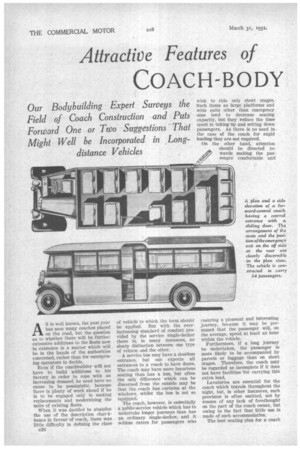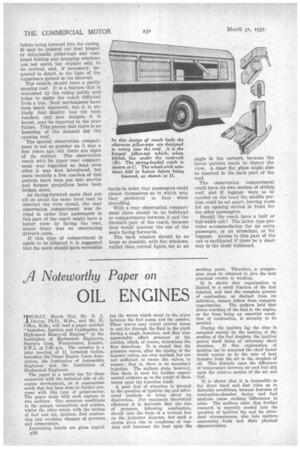Attractive Features of
Page 48

Page 49

Page 50

If you've noticed an error in this article please click here to report it so we can fix it.
COACH-BODY DESIGN
Our Bodybuilding Expert Surveys the Field of Coach Construction -and Puts Forward One or Two Suggestions Thal Might Well be Incorporated in Long distance Vehicles
As is well known, the past year has seen many coaches placed on the road, but the question as to whether there will be further extensive additions to the fleets now in existence is a matter which will be in the hands of the authorities concerned, rather than for enterprising operators to decide.
Even if the eoachbuilder will not have to build additions to his factory in order to cope with an increasing demand, he need have no cause to be pessimistic, because there is plenty of work ahead if he is to be engaged only in making replacements and modernizing the units of existing fleets.
When it was decided to abandon ' the use of the description char-abanes in favour of coach, there was little difficulty in 'defining the class -e26
of vehicle to which the term should be applied. But with the everincreasing standard of comfort provided by the service single-decker there is, in many instances, no sharp distinction between one type of vehicle and the other.
A service bus may have a doorless entrance, but one expects all entrances to a coach to have doors. The coach may have more luxurious seating than has a bus, but often the only difference which can be discerned from the outside may be that the coach has curtains at the windows, whilst the bus is not so equipped.
The coach, however, is essentially a. ptiblic-service vehicle which has to undertake longer journeys than has an ordinary single-decker, and it seldom caters for passengers who wish to ride only short stages. Such items as large platforms and wide exits other than emergency ones tend to decrease seating capacity, but they reduce the time spent in taking tip and setting down passengers. As there is no need in. the case of the coach for rapid loading they are not required. On the other hand, attention should be directed towards making the passenger comfortable and ensuring a pleasant and interesting journey, because it may be presumed that the passenger will, on the average, spend at least an hour within the vehicle. .
Furthermore, if a long journey be undertaken, the passenger is more• likely to be accompanied by parcels or luggage than on short stages. Therefore, the coach may be regarded as incomplete if it does not have facilities or carrying this extra load.
Lavatories are essential for the coach which travels throughout the night, but, in other instances, such provision is often omitted, not by reason of any lack of forethought on the part of the coach owner, but owing to the fact that little use is made of such accommodation.
The best seating plan for a coach
Is one with all the seats facing forwards. Longitudinal seats are often to be found over the wheel-arches, but such seats are usually the last to be sold or occupied. If all the seats are to face forwards the floor must be raised sufficiently in order that the obstruction of the wheel-arch be reduced to a minimum.
Raising the floor for the whole length of the vehicle entails an extra step at the entrance, but a compromise may be made by raising the floor only in the proximity of the wheel-arches.
As a -step some distance from the entrance is likely to prove a source of stumbling, the floor may be sloped upwards towards the . rear. This slope is made from 2 ft. to 3 ft. long, so as to make the incline easy to negotiate; and then the higher floor level is continued to the rear.
Such an arrangement may be adopted either with a front or rear-entrance coach, but it will be found to be more suitable for a frontentrance vehicle with its emergency door either in the middle of the back or on the off side at the rear, An advantage of this differentiation of floor level is that the passengers who are sitting over the wheelarches attd behind them have a better view forward than when the floor is at the same level throughout. Headroom of at least 5 ft. 10 ins, is provided above the higher seats, with 7 ins.or 8 ins. in excess of this measurement for the front rows on the lower level.
The coach will not be of greater overall height than will one having under-floor lockers, but much of the space which would be taken up by these lockers is added to the internal air'rspace of the main saloon. Thus the ventilation is enhanced and scope is afforded for increasing the natural lighting of the coach.
The coach, whether used for business or pleasure trips, should be designed to provide maximum observational facilities, because one of the chief reasons why the passenger travels by road is that he expects to obtain a closer view of the passing scene than is possible when travelling by rail. During a coach journey one is able to note not only the natural beauties of the countryside but also many interesting details of town and village life.
A chassis which has a lowloading line is desirable so that the floor may, for the reason already given, be raised wholly or partly without unduly increasing the overall height. Windows should be wide in order that there may be the least possible amount of obstruction as represented by the side pillars.
A • comparatively high waist line is still fashionable and it is retained ecause it helps to conceal tin high seat backs. But it is c msidered that a lower waist I ne would often be an improvement.
Another suggestion is that it would increase the enjoyment of a journey on a fine summer's day if the w' Ith of the window openings could be temporarily enlarged by swinging the alternate pillartops upwards. and faStening them under th6 cant-rail.
The windows over the wheel-arches would have to be specially designed, so that they could be concealed. These lights would have to fold in half, horizontally, 6efore being lowered into the casing. It may be pointed out that hinged or detachable pillar-tops and combined folding and dropping windows are not novel, but require only to be revived and, if necessary. improved in detail, in the light of the experience gained in the interval.
The vehicle should have a partly opening roof. It is a feature that is welcomed by the riding public and helps to make the coach different from a bus. Roof mechanisms have been much improved, but it is unlikely that finality has yet been reached, and new designs, it is learnt, may be expected in the near future. This proves that there is no lessening of the demand -for the opening roof.
The special observation compartment is not so popular as it was a few years ago, but there are signs of its revival. The observation coach with its upper rear compartment was regarded as dead soon after it was first introduced, but more recently a few coaches of this pattern have been put into service and former prejudices have been broken down.
As facing-forward seats that are all on about the same level tend to obstruct the view ahead, the rear observation compartment was devised in order that passengers in this part of the coach might have a better view by facing the rear, where there was no obstructing driver's cabin.
If this type of compartment is again to be adopted it is suggested that the seats should have reversible backs in order that passengers could please themselves as to which way they preferred to face when travelling.
With a rear observation compartment there should be no bulkhead or compartments between it and the forward part of the coach, because they would prevent the use of the seats facing forwards.
The back window should be as large as possible, with flat windows, rather than curved lights, -set at an
angle in the corners, because the latter pattern tends to distort the view. A clear flat glass might also be inserted in the back part of the roof.
The observation compartment could have its own section of sliding roof, and if luggage were to be carried on the head the middle portion could be set apart, leaving room for an opening section in front for the other passengers.
Should the coach have a half or full-width cab? The latter type provides accommodation for an extra passenger, or an attendant, or for luggage. Access to this part of the cab is facilitated if there be a doorway in the front bulkhead.












































































































